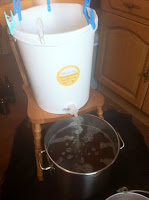After brewing this year's Christmas Ale, I was left with 70-odd grams of Cascade hops. After reading that it's Cascade that gives Sierra Nevada Pale Ale its aroma, I thought I'd brew up a pale ale to use them up.
This isn't supposed to be a SNPA clone at all, just something nice and hoppy. I'm using a bit of Munich malt to supplement the grain bill too, for the first time.
The yeast is a starter I've been culturing from the dregs of a few bottles of Hop Back Summer Lightning. Reculturing yeast from bottle conditioned beers is something I'm going to try to do more, because it's cheap, and I get to call the drinking of the beer "research". Yum.
I'm calling it "Promised Lightning" because of the Golden Promise malt and the Summer Lightning yeast. Also, it's more like an Amber than a Pale.
Anyway, here's the recipe:
4kg Golden Promise Pale Malt
1kg Munich Malt
150g Crystal Malt
40g Northern Brewer Hops (90 min boil)
1tsp Irish Moss (20 min boil)
24g Cascade Hops (5 min boil)
50g Cascade Hops (added at end of boil)
The grain was mashed in 14 litres of water at 66C, and sparged with 17 litres at between 75C - 80C
 The wort was cooled and siphoned off into a fermentation bin, at which point the gravity was 1.048 - just about exactly the gravity I was aiming for. I want this beer to be fairly strong, but not too strong.
The wort was cooled and siphoned off into a fermentation bin, at which point the gravity was 1.048 - just about exactly the gravity I was aiming for. I want this beer to be fairly strong, but not too strong. The yeast I pitched was, as noted, Summer Lightning yeast, retrieved from 4 bottles (hic!), and added to 100ml then 250ml, 550ml, 750ml and finally 1 litre starters made with Munton's "Beer Kit Enhancer" to an OG of about 1.040, over the course of about a month.
The yeast I pitched was, as noted, Summer Lightning yeast, retrieved from 4 bottles (hic!), and added to 100ml then 250ml, 550ml, 750ml and finally 1 litre starters made with Munton's "Beer Kit Enhancer" to an OG of about 1.040, over the course of about a month.
The yeast took off like a rocket! The picture on the left was taken after about 8 hours of pitching. The one on the right, with the mighty head of krausen was taken after 24 hours. Not sure what yeast the boys at Hop Back use, but I like it.
Fermentation update: it may have taken off like a rocket, but it sure slowed down after a the first week. It took seven days to get down to 1.021, and then another 13 days to get down to 1.015. It finished after 29 days, a lot of rousing and some yeast nutrient, at 1.012, meaning an approximate abv of 4.7%
Update: Tasting notes, etc.
A couple of months in the keg now, and I've sunk a couple of these over the weekend. It's very nice, but it isn't what I originally intended to get. The most notable contributor to the taste is the malt characteristics - malty, but without being too sweet. Hops are less pronounced, leading to a good balance to the beer. The head is creamy and thick, even when the glass is half-emptied.
I'm still not 100% happy with it overall. There's a very slight note of yeastiness in the after-taste. That might settle out with more maturation time, but it's nice enough that the keg won't last long enough for that. I'm planning on not touching the bottles for a minimum of 12 months to see how it tastes after a really good cellaring.
Not bad for only my fourth all-grain beer. But still a lot to learn.











Looks delicious. Nice blog too, I'll add it to my homebrewing bookmarks...cheers.
ReplyDelete---DeGarre
Hi Matt - any comments on the final taste of your Cascade brew? Waiting in anticipation!
ReplyDeleteI'm looking for a Dark Star Hophead clone and this could be it.
Phil
Hi Phil,
ReplyDeleteI've added some tasting notes above. I've not tried Dark Star's Hophead, but I can't imagine this beer tasting like something called "Hophead".
Really, it's showing off the maltiness from the big pile of Munich in the grist, more than it is the grapefruity freshness that you can get from Cascade.